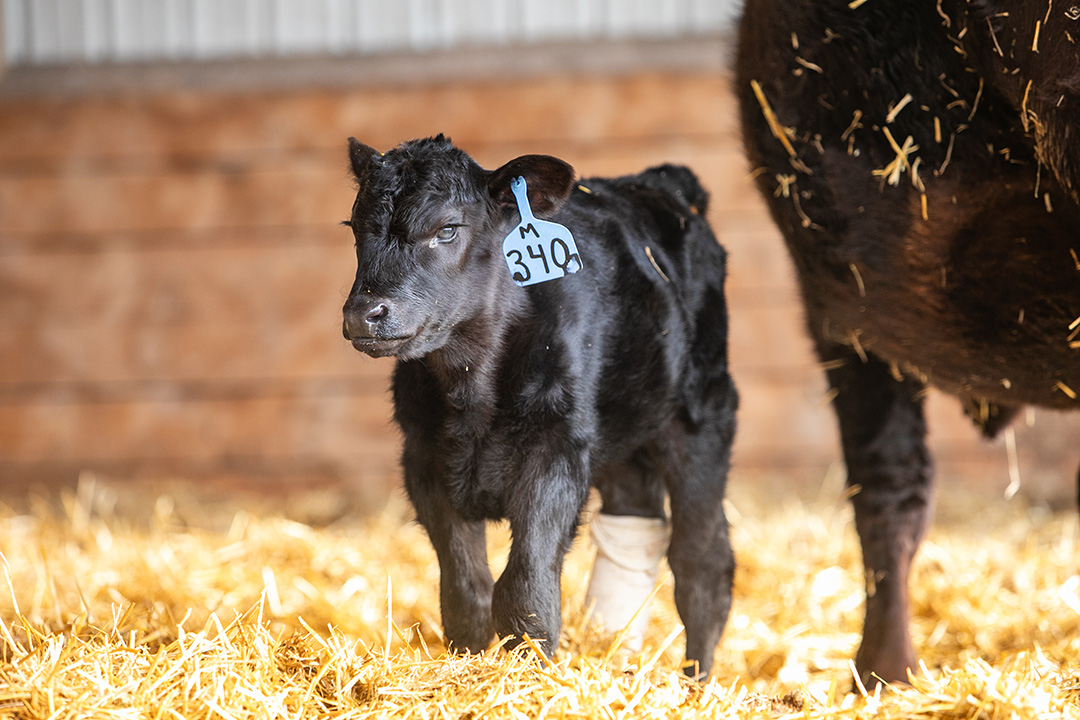
Veterinary students assist in injured calf’s recovery
During a calving rotation at the Livestock and Forage Centre of Excellence (LFCE) this spring, a team of senior veterinary students from the Western College of Veterinary Medicine (WCVM) gained hands-on experience assisting a young calf with a fractured limb.
By Tyler SchroederDuring a calving rotation at the Livestock and Forage Centre of Excellence (LFCE) this spring, a team of senior veterinary students from the Western College of Veterinary Medicine (WCVM) gained hands-on experience assisting a young calf with a fractured limb.
“Peggy,” one of the 400-plus beef calves born at the LFCE this spring, had accidentally been stepped on in the first week of her life and had suffered a leg fracture that required immediate medical attention.
“Calves that are less than a week old are very small and are adjusting to their new environments. They like to sleep a lot and don’t respond quickly to movements of larger animals around them. So, they are vulnerable to being accidentally stepped on,” says Dr. Colin Palmer (DVM), an associate professor in WCVM’s Department of Large Animal Clinical Sciences who co-ordinates the college’s calving rotations at the LFCE.
Since 2021, fourth-year WCVM veterinary students have participated in annual calving rotations at the LFCE where they gain practical experience working in real calving situations and caring for calves in the neonatal stages of their lives. Students assist in the birthing process and tend to unexpected needs — including assessing and treating injuries.
Palmer was with the student team when they examined Peggy and diagnosed her with a fracture in the metacarpus of her lower left hind leg, an area that’s prone to breaks in postnatal trauma. He says that broken limb calf cases aren’t very common in a herd environment. Despite their rare occurrence, he says it’s something that livestock producers have to watch out for in young calves.
“Most fractures involve the metacarpus or metatarsus, which is located in the lower part of the leg. Because there is little muscle protecting this part of the limb and the bone is less substantial, it’s a vulnerable area for injury,” says Palmer.
He recommended that the calf be sent to the WCVM Veterinary Medical Centre’s Large Animal Clinic for casting. The students accompanied the calf to the clinic, where large animal surgeon Dr. James Carmalt (VetMB, PhD) reduced the fracture and gave Peggy her first cast. The initial cast was worn for three weeks before being recast because of her growth. The calf will wear her second cast for three to five weeks before reassessment.
Peggy’s student caregivers included Jessica Buchel, Kiara Ernst, Tiffany Matejka, Georgia-Rae Maxwell and Matthieu Taillon – all fourth-year veterinary students at the WCVM. Aline Lebastard also participated in the LFCE calving rotation as part of her training as a veterinary technology student at Saskatchewan Polytechnic.
Fortunately for Peggy, Palmer says these types of fractures in calves typically heal well with casting. Peggy is still mobile as she learns to walk on the cast and her small size presents some advantages to herself and the veterinary team that’s helping her recover.
“Young calves are small compared to grown cows and heifers, so they are easier to handle and transfer for treatment. They’re also not big enough to damage the cast with their movements so we don’t have to worry about that.”
Palmer highlights the importance of having top facilities like the LFCE and resources for veterinary students to develop new skills and experience in critical situations. Located south of Clavet, Sask., the world-class agriculture research and teaching centre includes the Forage and Cow-Calf Research and Teaching Unit where the spring calving takes place.
“We’re really lucky to have such a great facility in the LFCE — with close proximity to the WCVM — that offers a wide range of opportunities.”
